Journey into the heart of Ancient Rome at the Roman Forum.
Discover the center of Roman society at the Forum, where laws were decreed, politics discussed, and goods bartered.
This is the beating heart of Ancient Rome: an unmatched social, economic, religious, and political powerhouse.
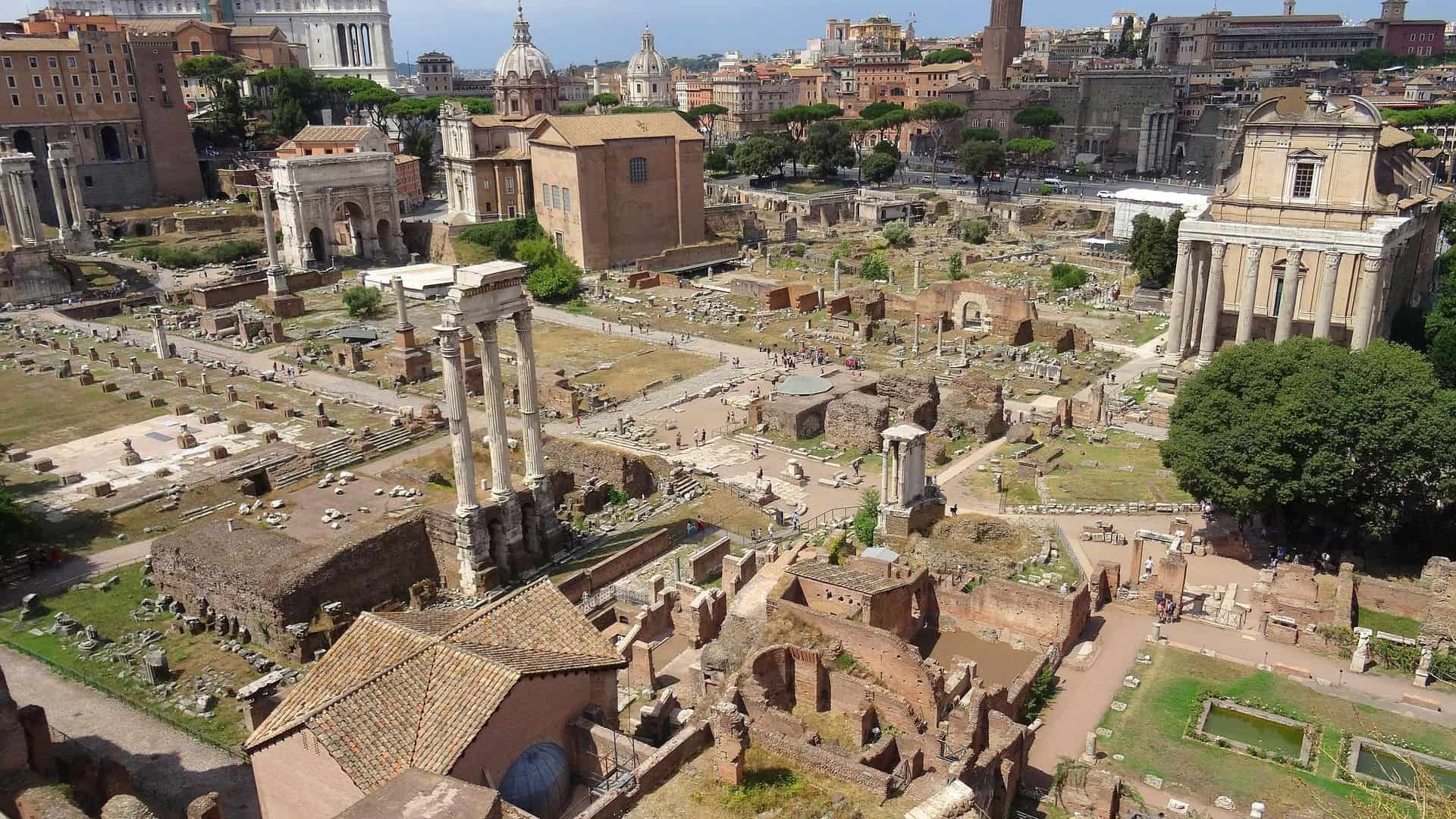
Highlights
- Wander down the Via Sacra, the Main Street of Ancient Rome.
- Visit the temple and home of the Vestal Virgins – and discover where they would tend to the sacred eternal flame of Rome.
- Weave between the ruins of temples, meeting halls, and monuments in the Forum, and see the gravesite of the infamous Julius Caesar.
Everything You Need to Know About Visiting the Forum
Your entry to the Roman Forums and the Palatine Hill is usually included with your Colosseum ticket since the Forum is part of the same archeological park (Parco Archeologico del Colosseo).
The great thing is that it’s valid for 24 hours before or after your entry to the Colosseum. This means you are not obliged to see both on the same day. In fact, for reasons I’ll go through with you below, I would wholeheartedly recommend you see the Roman Forum first (ideally the afternoon before) and then see the Colosseum the following morning.
To get there, you have two options. Either you take the main entrance via Via Sacra (opposite the Colosseum) whereby you enter through the Arch of Titus OR enter from Via di Gregorio (just after the Arch of Constantine) for a more relaxed way in.
I’ll show you the Via Sacra entrance way as, while the busiest, is also the most evocative. But it’s your call.
This guide assumes you have a prebooked ticket with no guide.
Tickets & Prices
Explore the Roman Forum with ease by purchasing a ticket beforehand. You won’t have to waste extra time in the purchasing queues and can breeze through the ancient site.
Find out which of these Roman Forum tickets is best suited to you.
- Colosseum, Roman Forum & Palatine Hill (Priority Entrance) – Skip the line with this priority entrance ticket.
- Colosseum, Roman Forum & Palatine Hill (Last Minute Priority Entrance) – Last minute ticket for Colosseum entry.
- Rome Tourist Card (Bestseller) – See the best of Rome with this popular combi-ticket. Includes access to The Colosseum, Roman Forum and Palatine Hill, Vatican Museums & Sistine Chapel, St. Peter’s Basilica (official guided tour), and more…
- Rome Super Pass with Public Transport – Skip-the-line entrance to some of Rome’s best attractions with this combi-ticket. Includes unlimited public transport PASS (metro, bus, tram).
Tickets for Colosseum, Roman Forum & Palatine Hill
Entrance to the neighboring ancient sites of the Colosseum and Palatine Hill is also included with these tickets. You get to skip the queues and also download a digital guide to teach you the history of your surroundings.
Important Ticket Information:
- The tickets are valid for two days (including the day of activation).
- Re-entry is not possible once you leave the site.
- Palatine Hill is open from 10:00 – 19:15. While both the Colosseum and the Roman Forum are open 09:00 – 16:30. The last admission is an hour before closing.
- You should head to the Via dei Fori Imperiali entrance to enter the Roman Forum.
- You can choose between 5 visit routes, which vary from 30 minutes to 2.5 hours.
Rome Tourist Card
The Rome Tourist Card is the ultimate pass for new visitors to Rome. It grants you access to the city’s most iconic sights, from Palatine Hill and the Colosseum to the Sistine Chapel.
It’s perfect for people hoping to tick off all the main tourist spots during their visit.
Important Ticket Information:
- Includes skip-the-line access.
- The Colosseum, Roman Forum and Palatine Hill, St. Peter’s Basilica, Vatican, and Sistine Chapel are the attractions included.
- It is a digital pass.
- There isn’t a time limit on the Rome Tourist Card – it can be used and remain valid throughout your stay.
- You can book time slots online.
Getting There
Take the Metro to Colosseo – on the B (blue) line, two stops after Termini.
Exit the station, and the Colosseum will be right in front of you.
You will be tempted to start taking photos immediately but trust me, there are way better spots from where to snap a selfie.
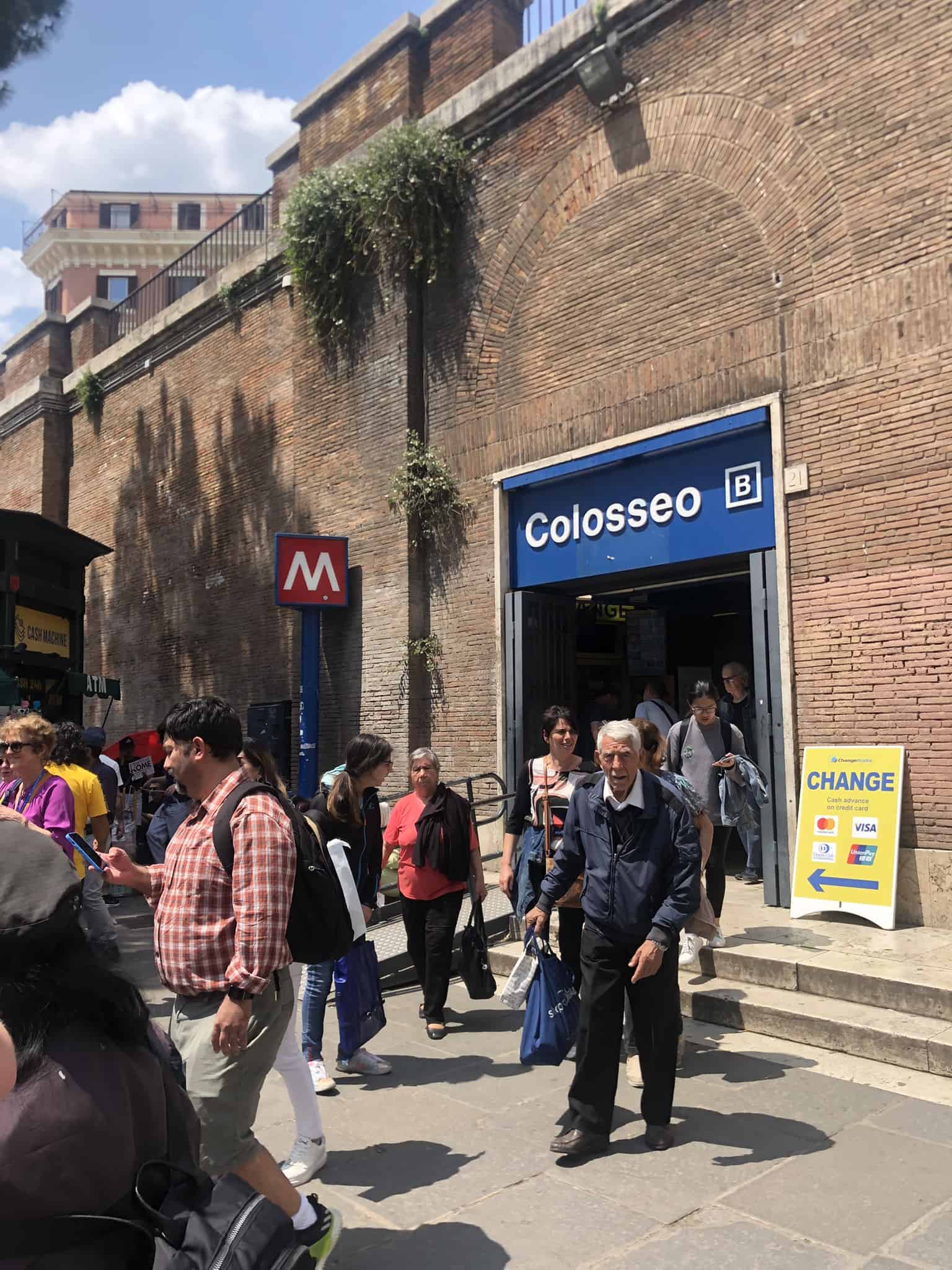
Neverending stream of people exiting the Metro statio
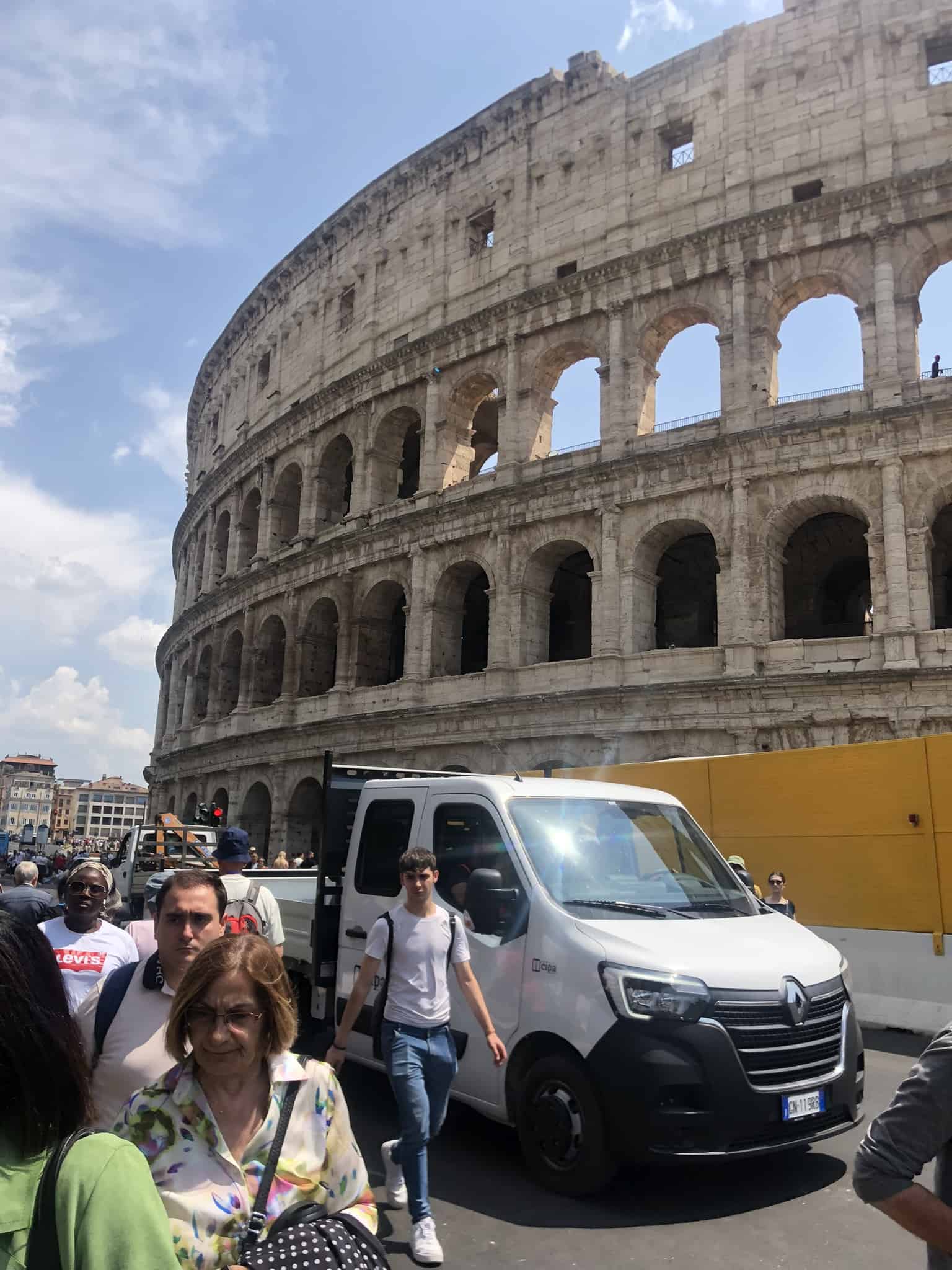
The Colosseum is directly opposite the Metro station.
The white and yellow panel obscures a construction site for a new Metro stop for the C Line.
It’s been a work in progress for over 20 years now, so something of a running joke among Romans.
- Top tip: Warning – there are two exits: lower level and upper level. After you come up the stairs and go through the ticket barriers, you’ll be on the lower level. Go straight out. You’ll be within sniffing distance of the Colosseum. You can’t go wrong.
(Lots of guided tours have their meeting point at this exit of the Colosseum Metro.)
If, on the other hand, you walked or took a taxi, you’ll most likely be taken to the upper level exit (either by your phone’s GPS or the taxi driver).
Enter the Metro station and take the stairs down. You’ll arrive at the lower floor level of the station, opposite the Colosseum.
Warning
There are a lot of illegal ticket touts still operating in this area. Think of them like the sun. Make no direct eye contact. Ever. No need to be rude or get angry with them if they pester you. Just keep walking.
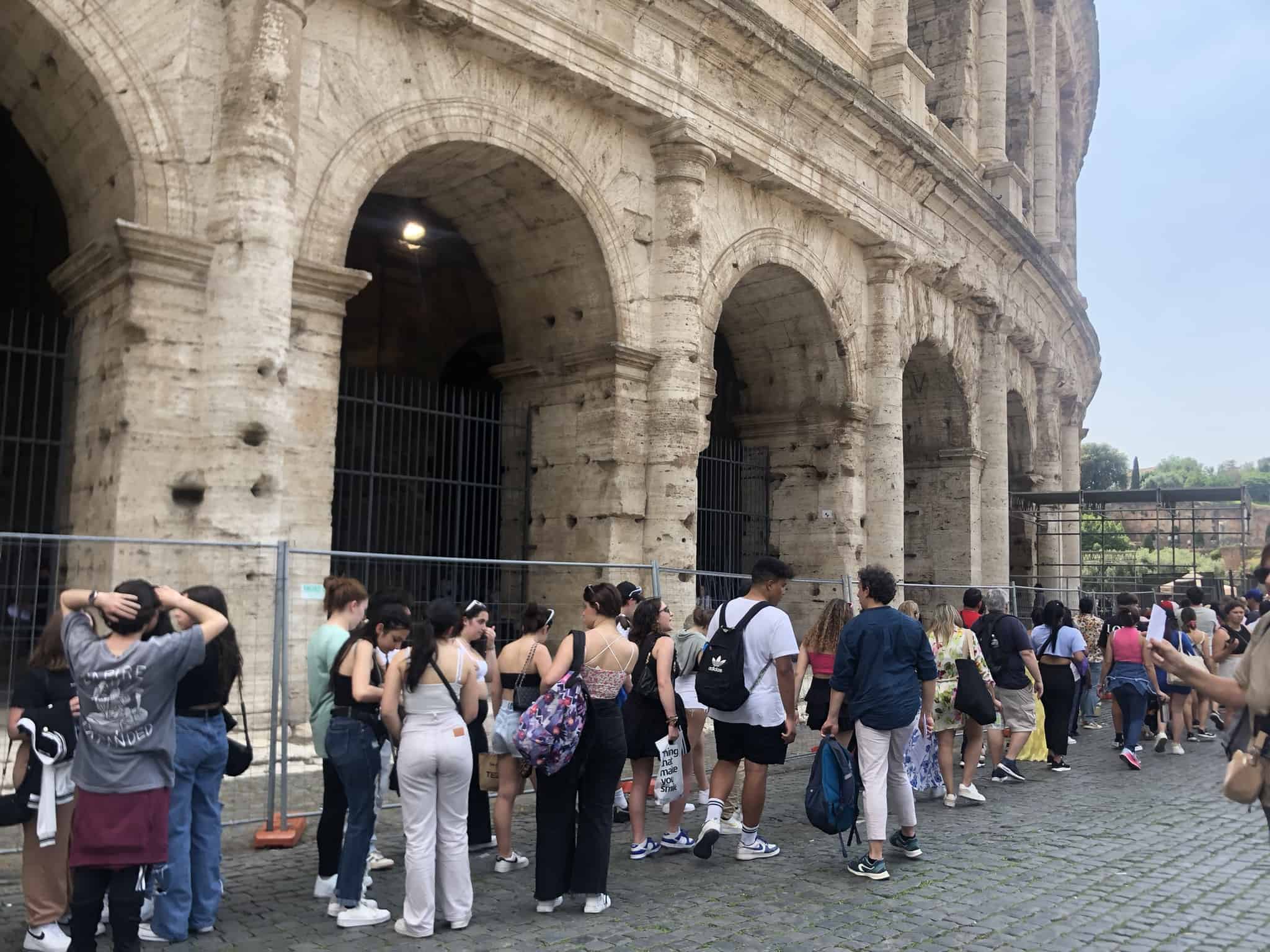
Group ticket holders’ line.
From the station, cross the road and as you pass the construction panel, you will probably see a very long line like this.
This line is for group ticket holders. They will be with their tour guide.
Follow the line for another 20 metres or so until you get to a sort of tree lined square, the other side of which will be another long line of people queuing up at the ticket office (see below).
Line for the ticket office opposite the Colosseum.
Cross over, walk past the ticket office and the line of people, and go straight until you come to Via Sacra and a sign indicating the way in that looks like this:
Entrance to Roman Forum on Via Sacra
- Top tip: Via Sacra is made up of huge shiny ancient cobblestones (much larger than the ones in central Rome known as San Pietrini). You’ll want to wear shoes with good grip.
Not sure how much of a flex this really is – there are literally hundreds of free potable water fountains in Rome. But it is the only water fountain at the Forum and with no cafes or restaurants, you will need it. You’ll find it just after the Arch of Titus.
- Top tip: Bring a refillable water bottle. There’s quite a lot of walking involved on Palatine Hill, and there are no restaurants. (Which is a shame because it would be very nice if there were).
Walk up the Via Sacra and you will be greeted by staff who will scan your ticket. You’ll go through a turnstile and then just like that, the epic Arch of Titus welcomes you in.
(I went in May 2023 which was ridden with days that started out with perfect blue sky and then ended with a thunderstorm. I liked it though; the sky, while ominous, just made everything a lot more dramatic.
- Top tip: Download the Parco Archeologico App. You can find it on the official Colosseum website or by scanning the QR code on the ticket information panels located next to the ticket office.
It’s invaluable for helping you get your bearings around the deceptively large Roman Forums and Palatine Hill.
Above: Arch of Titus, and the start of most Roman Forum itineraries. Remember that scene in Ghostbusters 2 when dark clouds gather over the museum right before it gets covered in ghost slime?
What You Can Expect To See
Basilica of Maxentius and Constantine – (313 C.E)
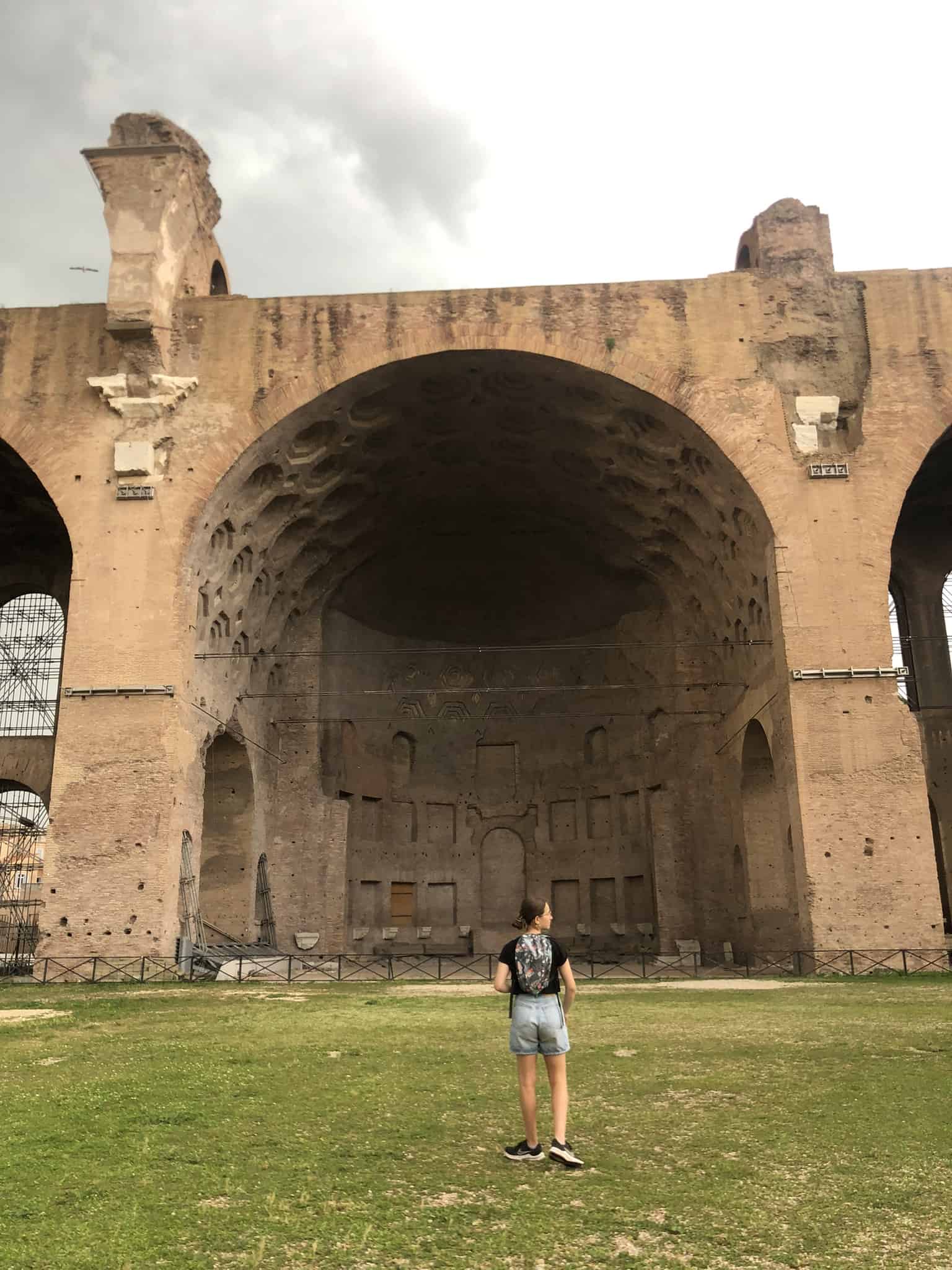
It’s really the scale that is the most impressive here.
The largest structure in the Forum, and of vast architectural importance; its design is said to have influenced the design of the St. Peter’s Basilica.
Artists’ renditions make it come alive, take a look before you go.
The Temple of Romulus – (300 C.E)
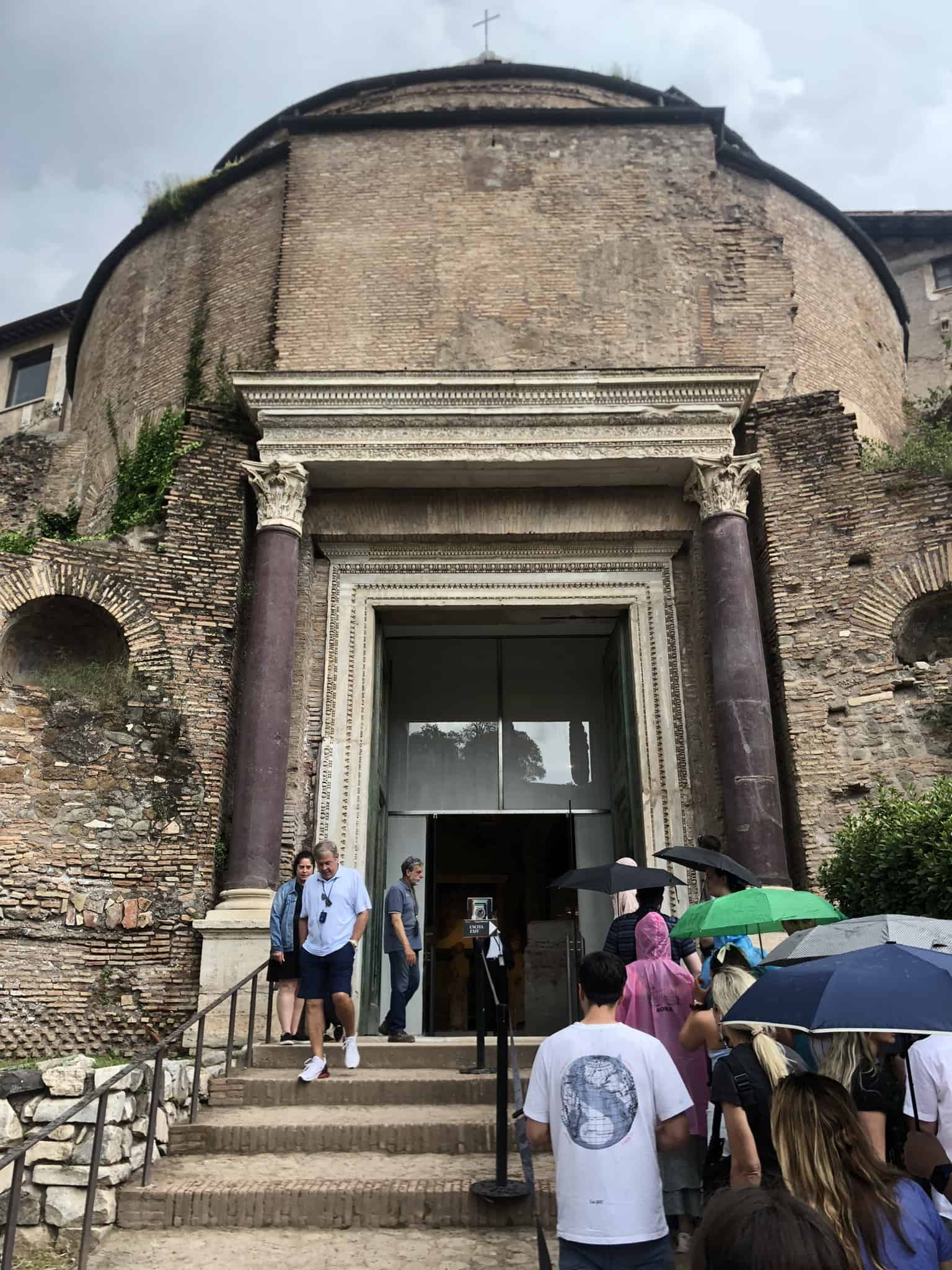
It’s unclear what the Temple of Divus Romulus was really used for other than an antechamber for the temple behind.
However, the bronze door, still used today, is 100% original. It was converted into a church in the 6th century.
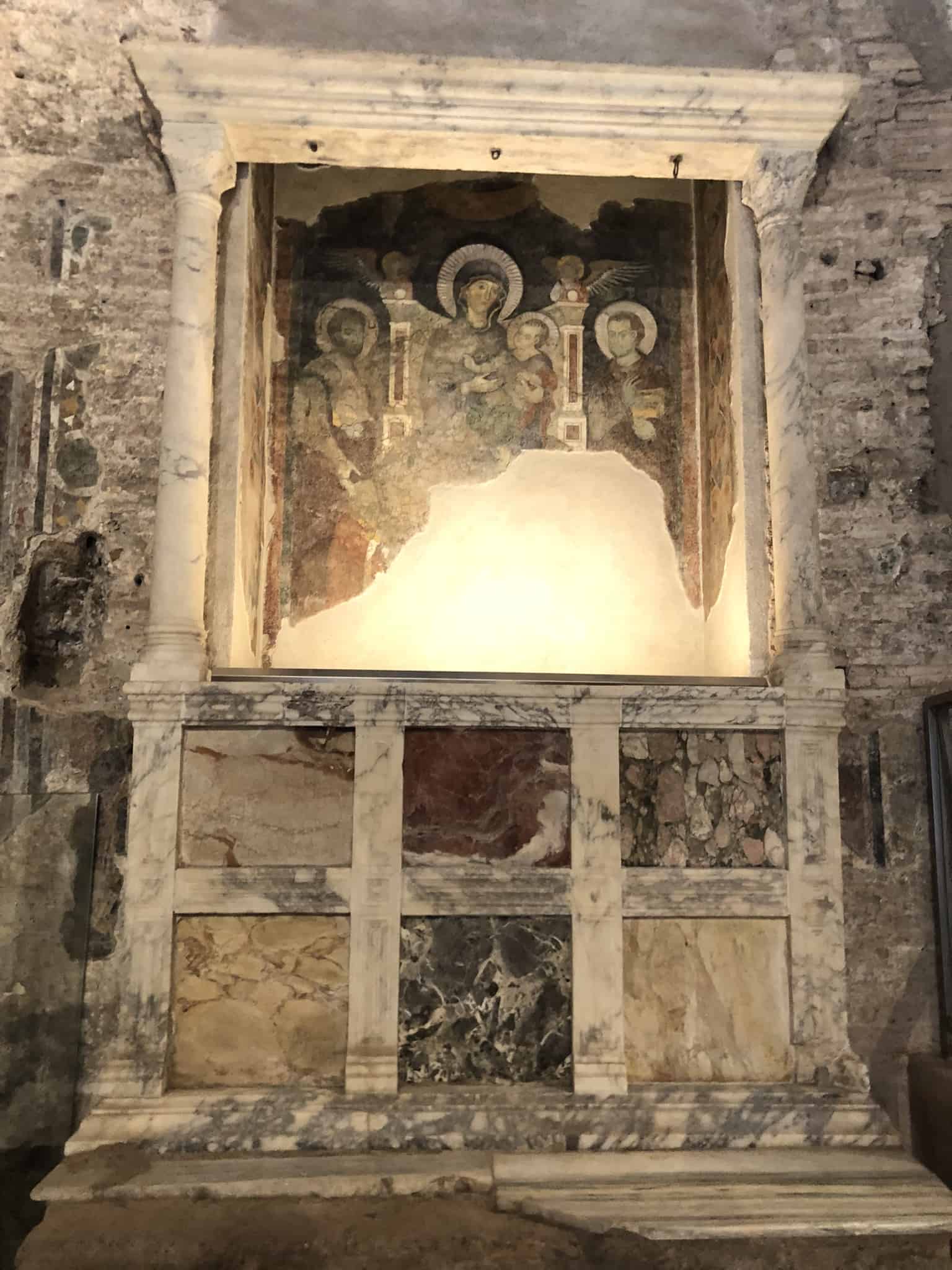
Detail of a fresco behind an altar from inside the Temple of Romulus.
The Temple of Antoninus and Faustina (141 C.E)

This one takes a second to figure out.
What’s that door doing up there?
19th-century excavations revealed the difference in street levels between Roman times and the 17th century. Contrast the threshold of the green door with the base of the steps leading up to the columns.
The Church, dedicated to San Lorenzo in Miranda is known as ‘the church in a temple’ for obvious reasons.
The Temple of Vesta
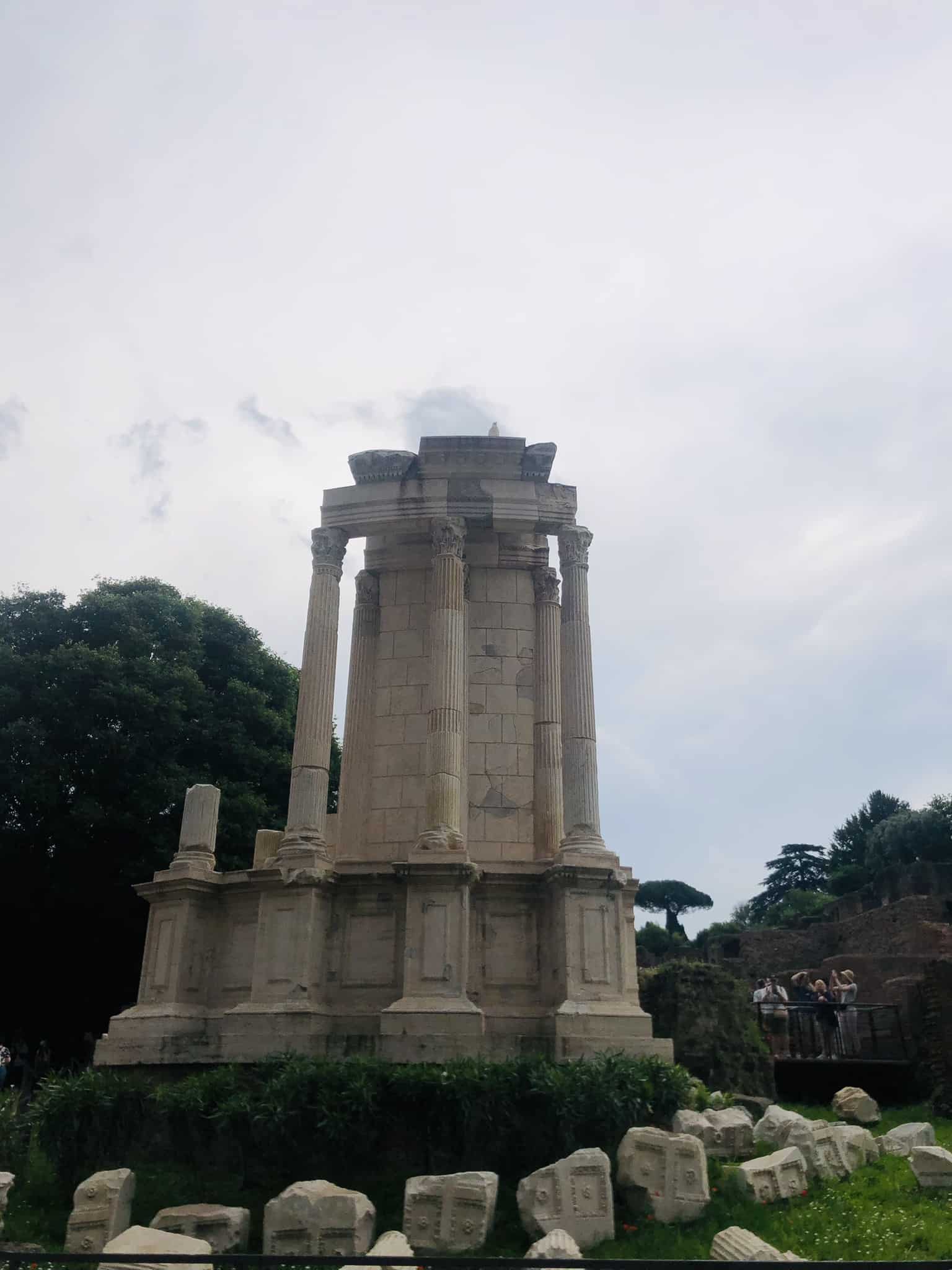
The oldest and most important shrine, it was home to the hearth which held the sacred fire of the state.
Religious activity on this site is estimated by historians to go as far back as 7th-century B.C.E.
Tempio dei Dioscuri
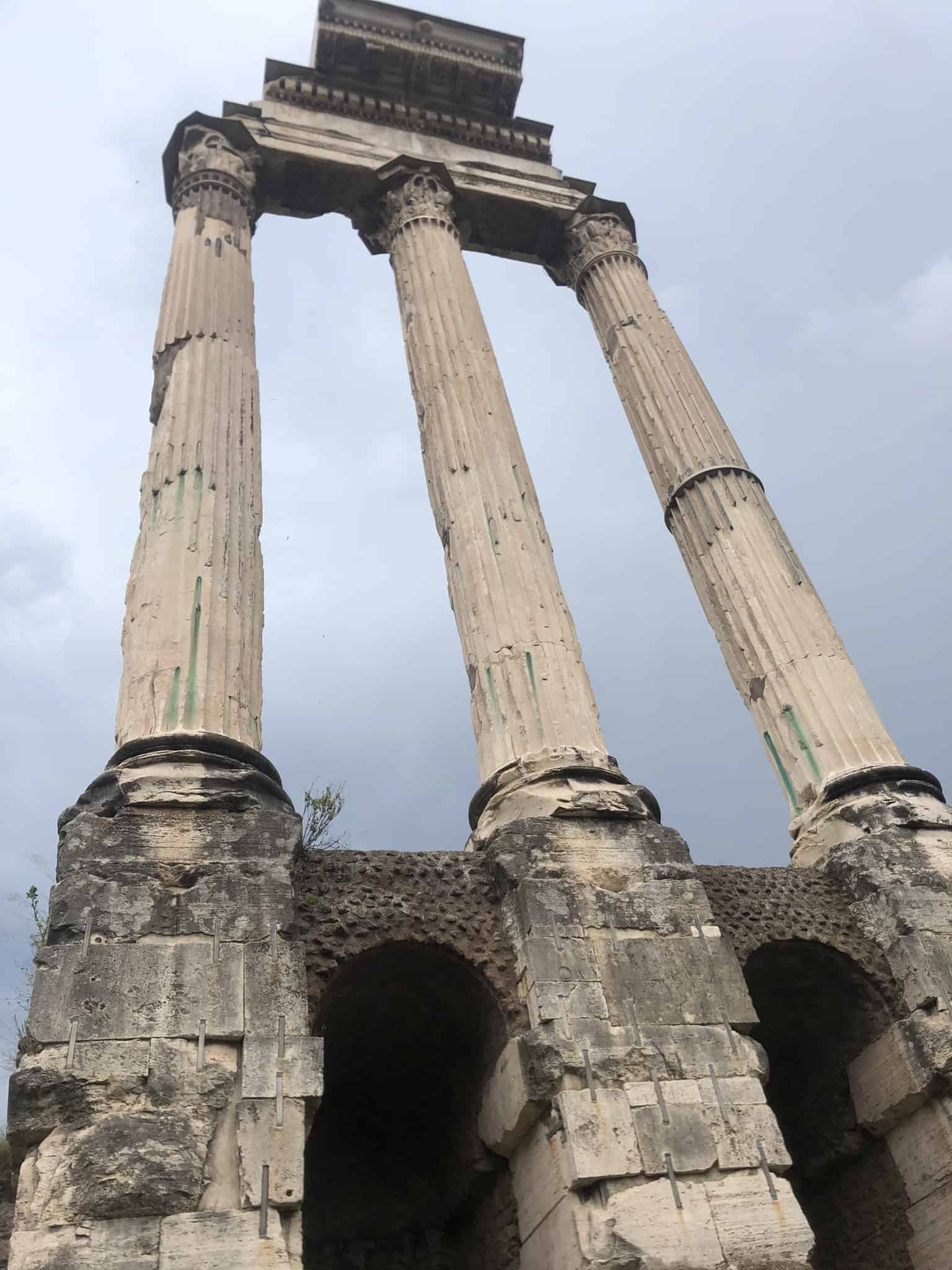
Temple of Castor and Pollux (Tempio dei Dioscuri).
Legend has it that the sons of Jupiter and Leda appeared on this spot to assist the soldiers of the Roman Republic overcome the last king of Rome.
Just these three columns remain, but they are iconic.
The Atrium Vestae
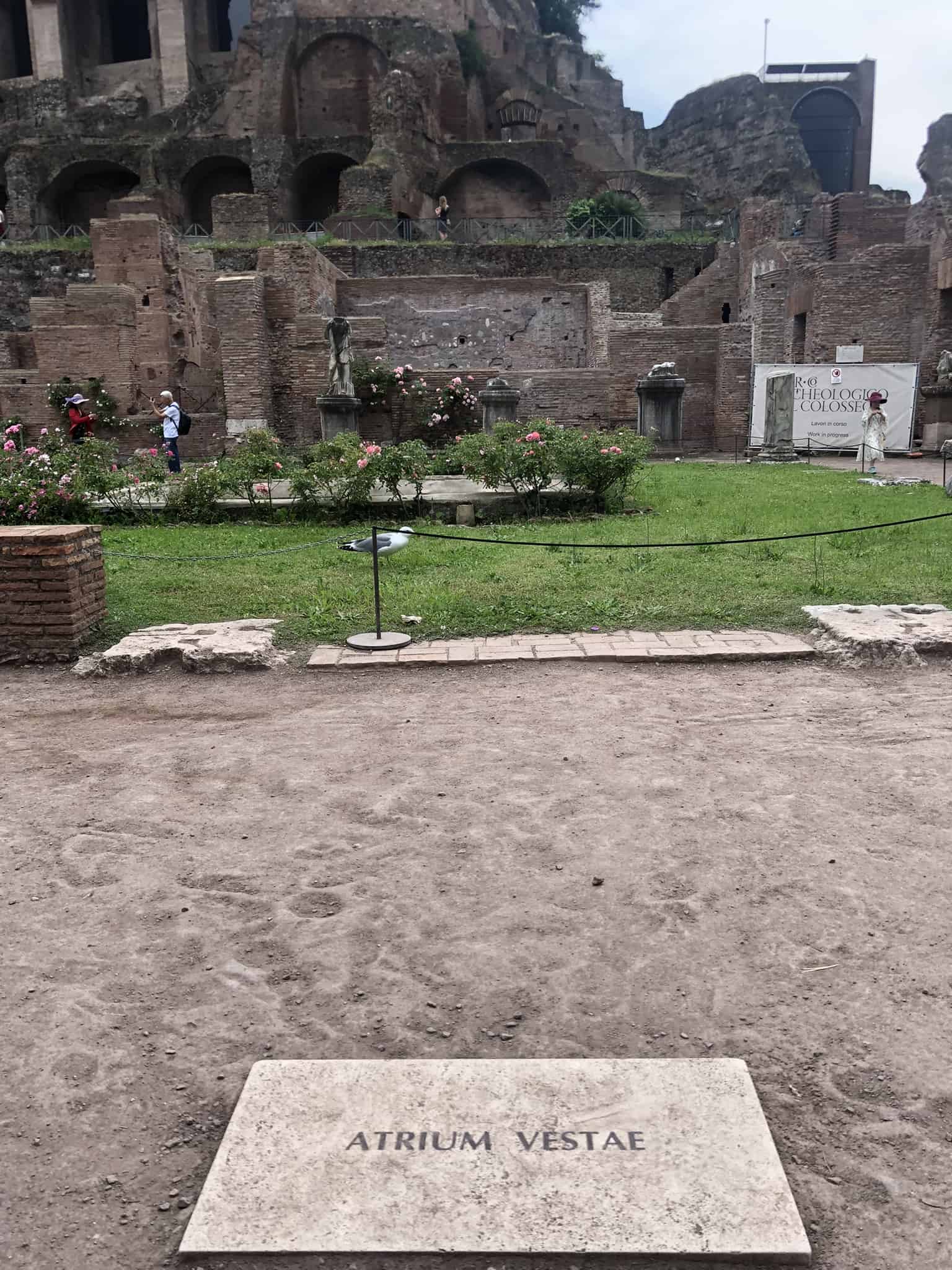
One of my favourite areas had to be the Atrium Vestae or the House of the Vestal Virgins.
(Vestal Virgins were women who would tend to the Temple of Vesta for a tenure of thirty years. As their title would suggest, they were virgins and were expected to remain celibate).
There are benches and it’s a great place to sit down, soak up the atmosphere, get your bearings, and prepare yourself for the Palatine Hill.
(See below for a super quick history lesson and why this is extra relevant).
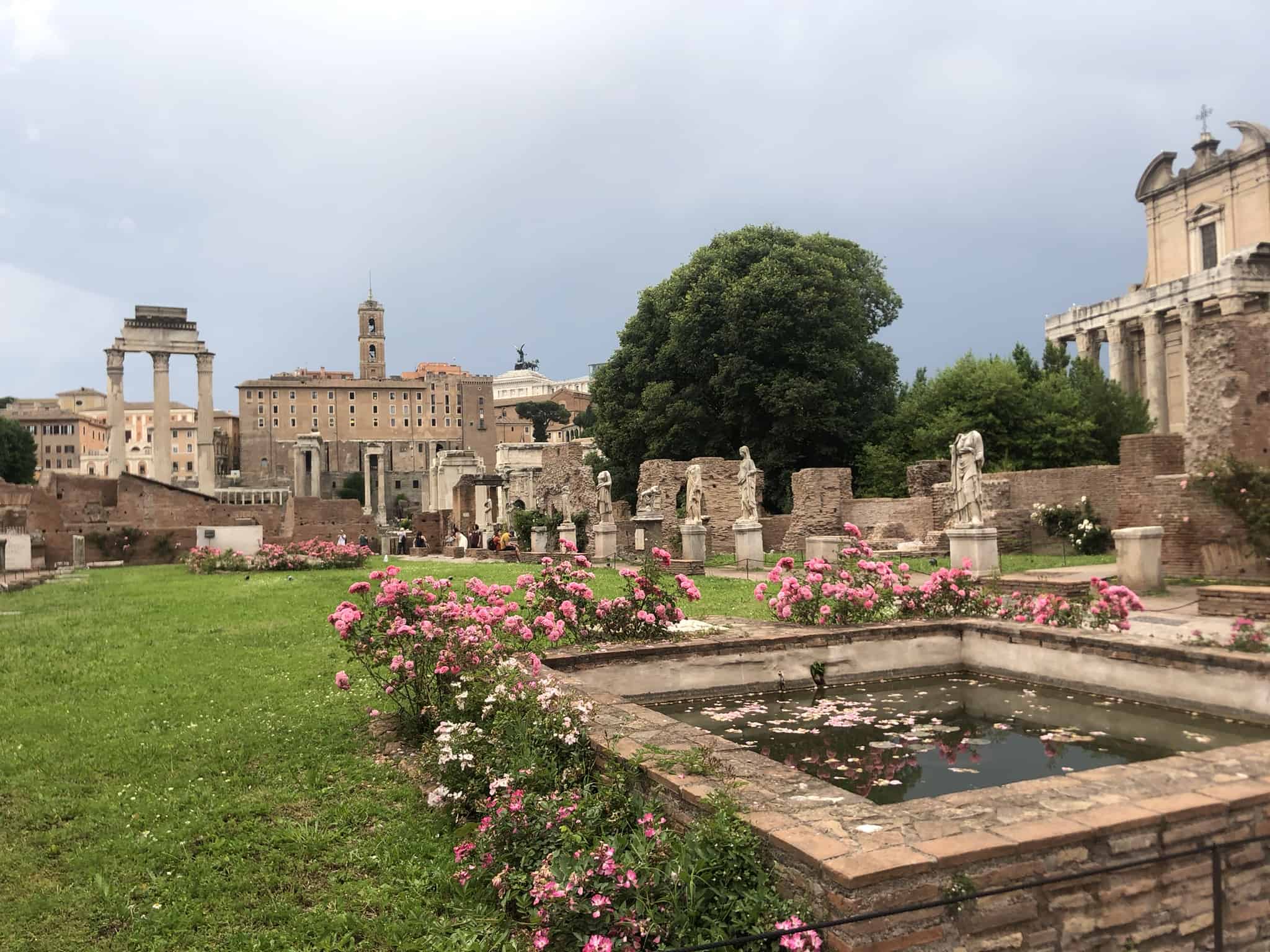
View of Tempio dei Dioscuri and Temple of Antoninus and Faustina from House of the Vestal Virgins, now a very serene rose garden.
Vestal Virgins
According to Roman mythology, a vestal virgin called Rhea Silvia was impregnated by the god Mars. She gave birth to twins and called them Romulus and Remus.
The King perceived the sons of Mars to be a direct threat and so ordered them to be killed. They were abandoned by the river but saved by the god Tiberinus, Father of the River.
As infants, they were suckled by a she-wolf (Lupa), and the cave (the Lupercal) in which she cared for them was believed to be up on Palatine Hill.
(If you ever wondered why the symbol of Rome was a wolf).
Years later, Romulus and Remus entered into a bitter dispute over where to build the city. Romulus favoured the Palatine Hill. Remus did not, so his brother had him killed. Romulus founded the city, called it Rome and the rest is history.
Palatine Hill Overview
The Palatine Hill has so many layers to it; both historically and mythologically.
It was home to the ruling classes of Rome for literally millennia. It’s dominated by the ruins of a network of imperial palaces from the first century called the Domus Augustana.
After a brief period of decline during the Middle Ages, things picked up again in the 16th century, when Palatine Hill became home to the first-ever botanical gardens in Europe thanks to the Farnese family.
Just a couple of pavilions and a fountain from what were once the most highly rated pleasure gardens in Europe.
The Palatine Museum at the top of the hill will help fill in the gaps showcasing the wealth and splendour of its previous inhabitants and their respective residences.
Cap it off with stunning views over the Circo Massimo from the Domus Augustana, before exiting via the Barberini Vineyard back down to Via di San Gregorio towards Circo Massimo.
Exploring the Palatine Hill
I started by exploring the vast imperial complex Domus Augustana. To add to the regal feel, classical music is played across the Domus area from discreetly placed speakers, which for me, went perfectly with the surroundings. It instilled a wonderful sense of calm:
Despite all the signs, it’s also quite nice to explore the park and then just organically find yourself in the Farnese Gardens.
The Nymphaeum of Mirrors
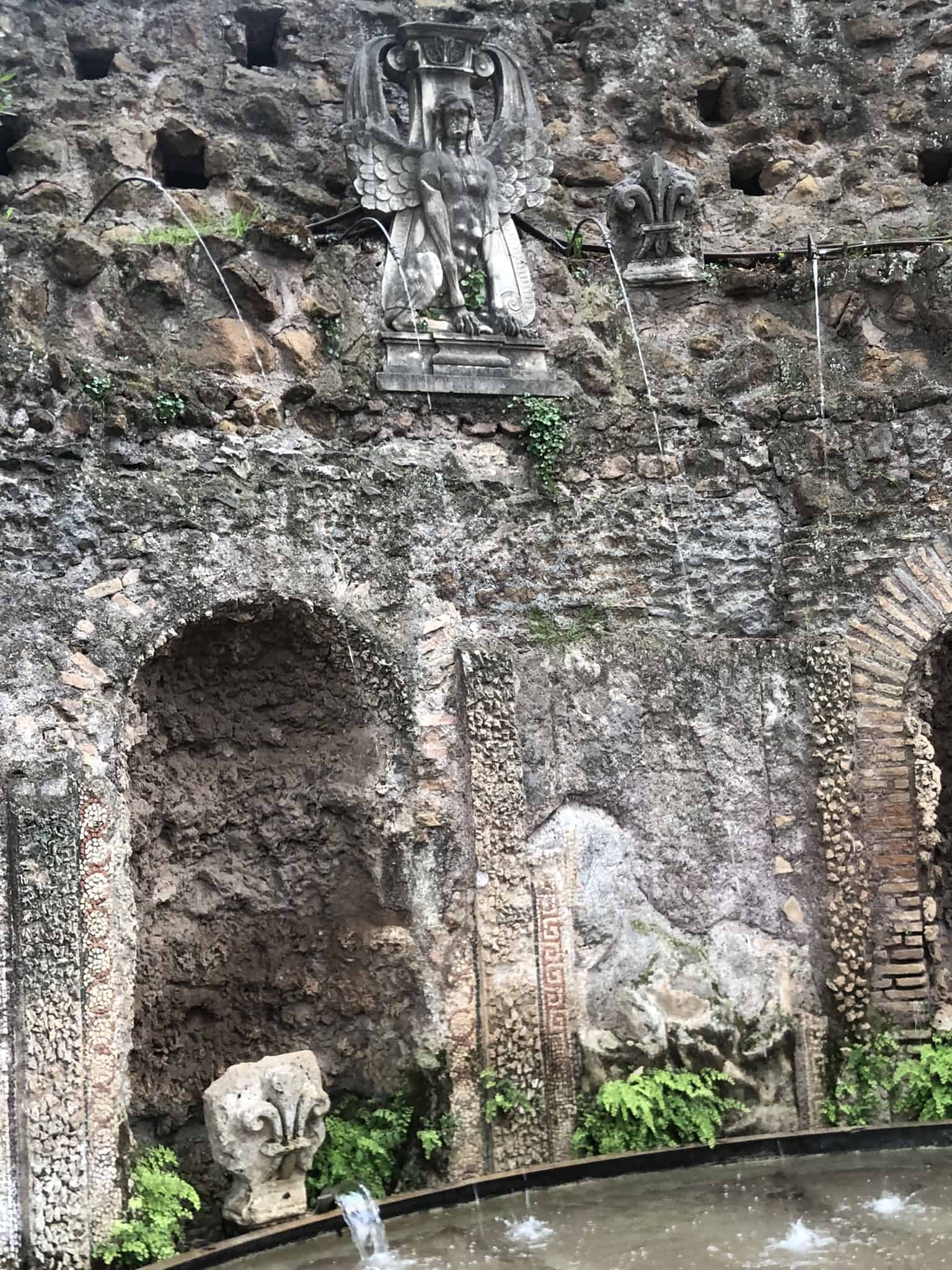
From here, I could still hear the classical music being played up the hill. I sat on a bench opposite the Nymphaeum of Mirrors – or what remains of these fantastic 16th-century water jets and fountains.
I still couldn’t quite get over how still and peaceful it was.
- Top tip: aim your visit towards the end of the day. Not only might you be lucky enough to enjoy romantic twilight views over the Circo Massimo from up on high, but it will be much quieter. Plus, you’ll wind everything up just in time for an aperitivo (between 6 pm and 7 pm), and I’ve got just the place in mind.
Making Your Way Out
Rather than going back the way you came and taking the Metro at Colosseo, exit here through Vigna Barberini. This lovely, almost rural walk downhill past random bits of Roman aqueduct will take you to the entrance/exit on Via di Gregorio, close to Circo Massimo.
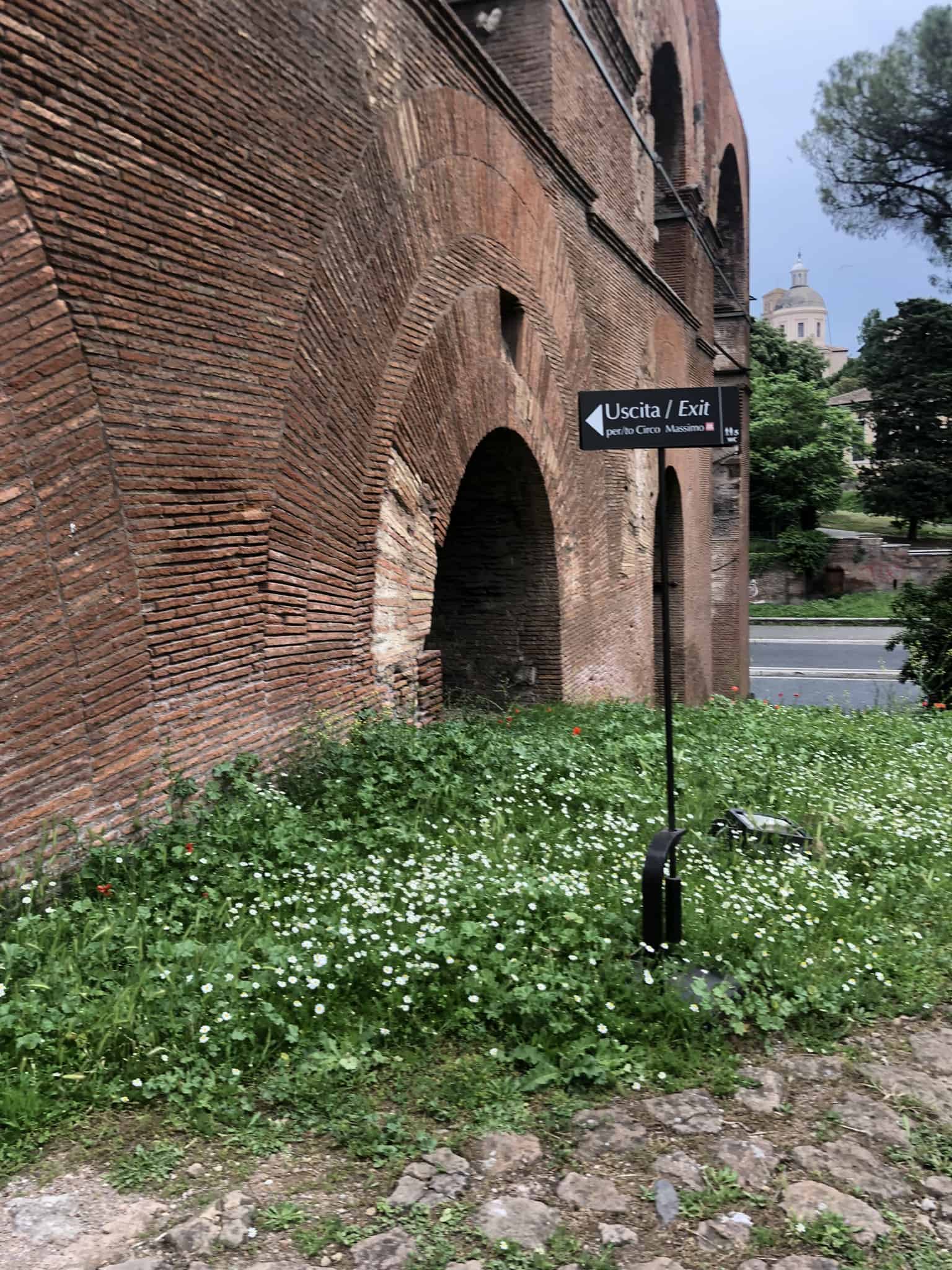
The Barberini Family Vineyard
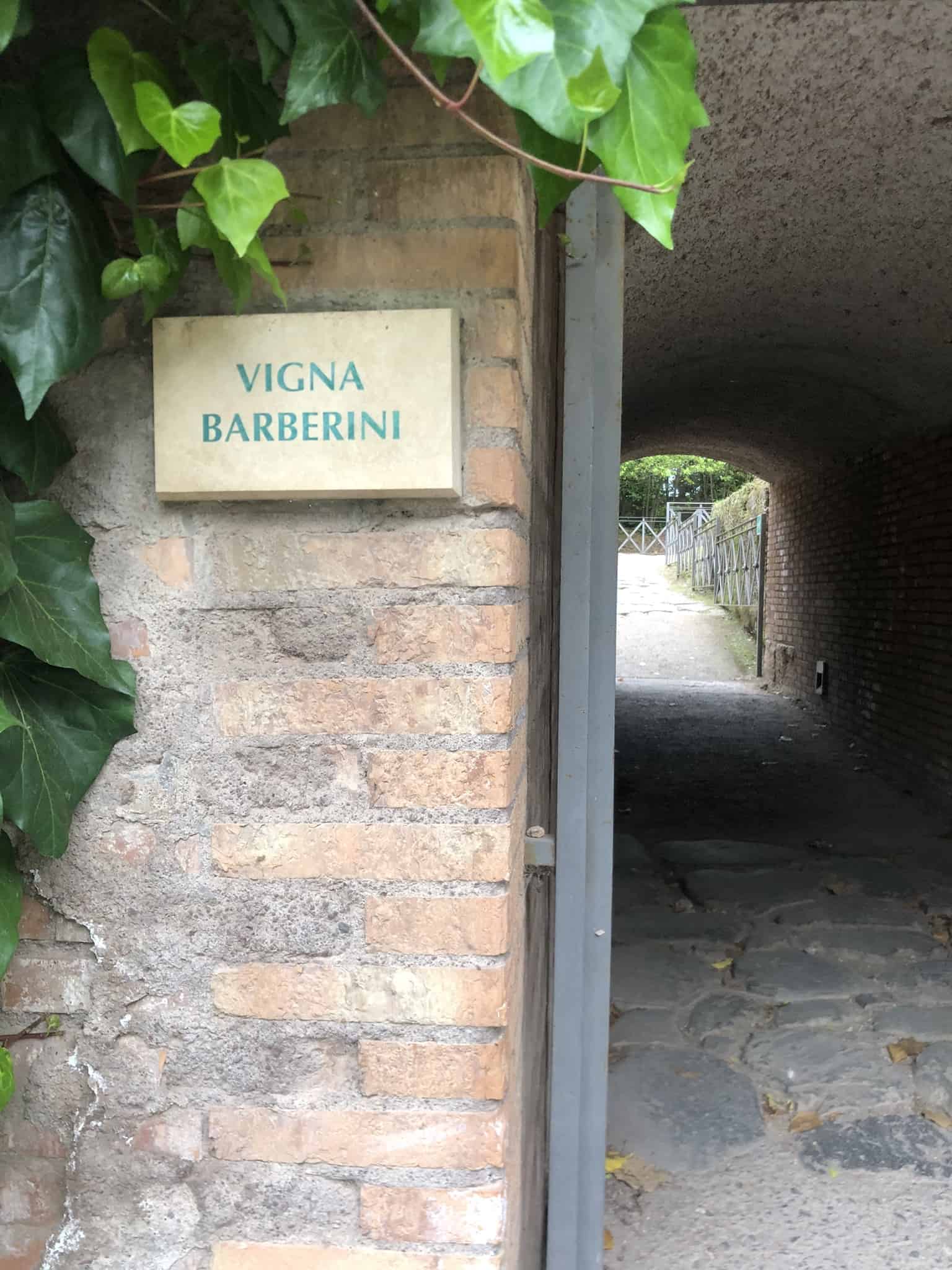
Now here’s a family that got around. This was a noble family from the 17th century that had their fingers in a lot of pies. (You’ll see their family crest at St Peter’s and they even have a Metro station named after them)
They owned property on this site in the 17th century, but the vineyard we see today was carefully planted in 2020 and viticulturalists are proud to be cultivating a very ancient vine called Bellone, known to have been used in Pliny the Elder’s time.
I visited towards the end of the afternoon and had the place to myself.
A very rural feel to the way out via the Vigna Barberini.
The path above will take you all the way down to Via di Gregorio and the splendid arch below.
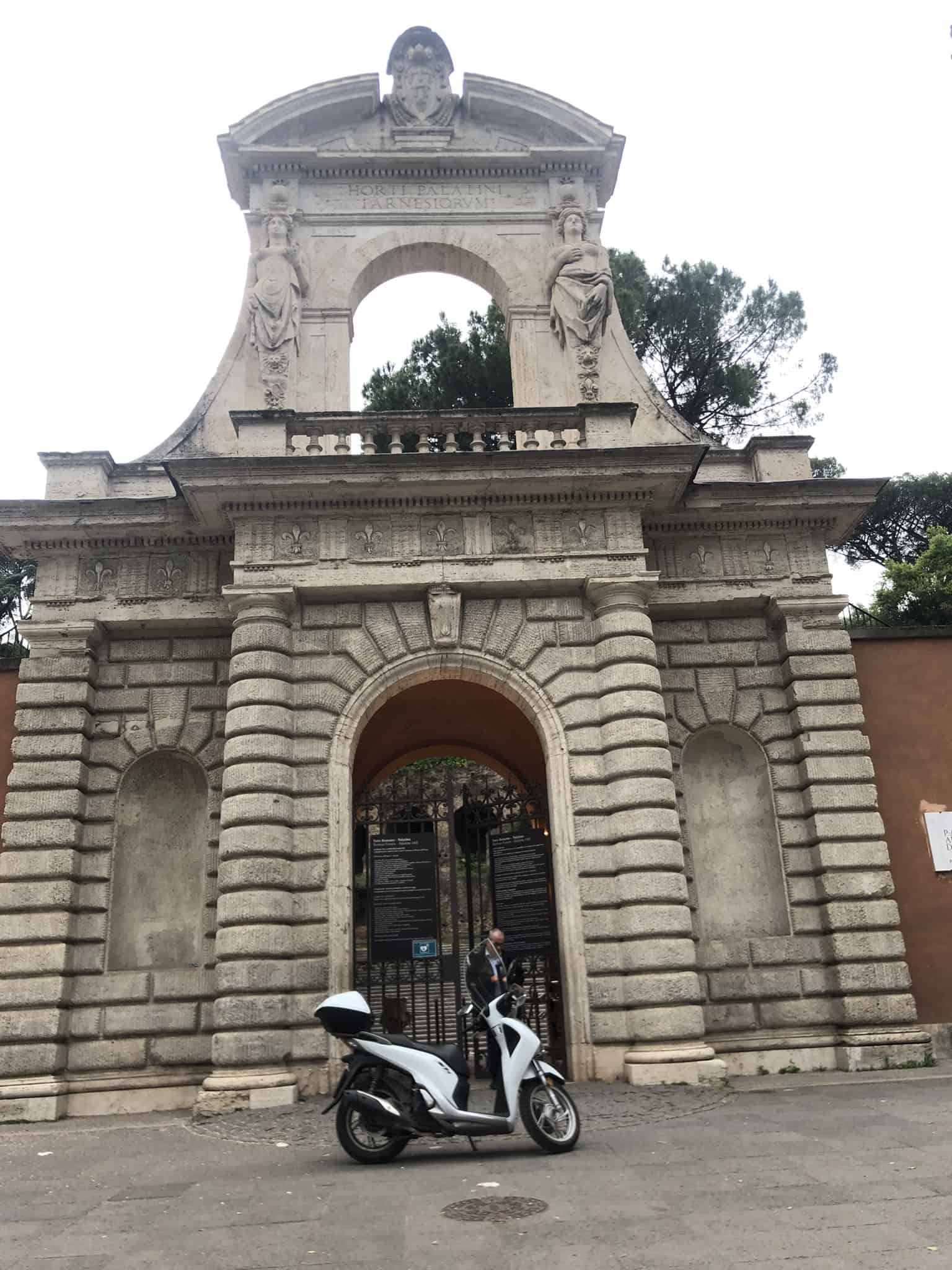
The entrance on Via San Gregorio, or the exit if you choose the Circo Massimo exit. The original entrance to the Farnese Gardens, when they were still a thing.
As you exit this splendid arch, the Arch of Constantine and the Colosseum will be on your left, and the Circo Massimo on your right hand side.
You could also choose to do the reverse and start your visit from here instead.
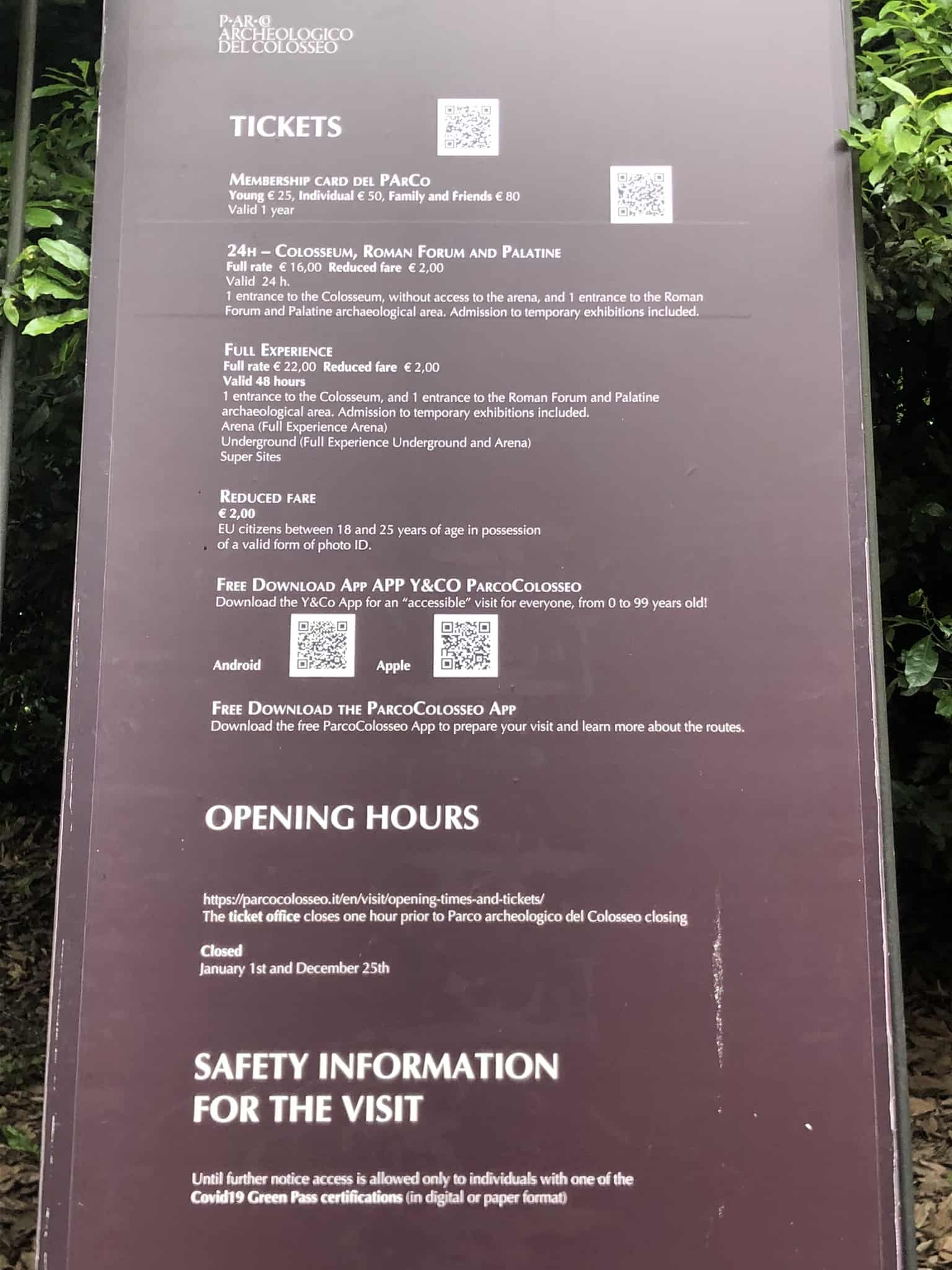
Italy has an absolute love affair with QR codes. They have them for everything.
This ticket information sign also has the QR code you need to download the Parco Colosseo App which includes a detailed itinerary for the Forum as well. Highly recommended.
You’ll find another sign like this by the ticket office opposite the Colosseum, next to Via Sacra.
Be aware that there are no gift shops, cafes, or restaurants at the Roman Forum or Palatine Hill. So bring snacks. The only official gift shops are located within the Colosseum.
Nearby Attractions
Circo Maximo Experience – Viale Aventino, 00186
Through the use of Virtual Reality headsets, you’ll be transported back to the 1st century C.E and witness chariot races and a slice of Ancient Roman life at the Circo Massimo. A 40-minute walking tour; it’s a mere five-minute walk from the Arch of Constantine.
Panoramic view of the Circus Maximus as seen from the Palatine Hill.
Basilica San Clemente – Piazza di S. Clemente, 00184.
A five minute walk away is a stunning 12th century church.
Beneath lie archaeological excavations that take you on a voyage through time. You’ll go down to the remains of a 4th century church, and then descend once again to a 1st century pagan temple.
You’ll need to book ahead. The basilica itself doesn’t provide guided tours (local tour providers take care of that), and you will need to make sure you dress appropriately. No bare shoulders or short shorts.
Food and Drink
Bars and restaurants directly opposite the Colosseum are, not surprisingly, tourist traps. It had to be said. Instead, head to Viale Aventino; the long and cosmopolitan avenue (thanks to all the expat UN staff who frequent its bars) which connects Circo Massimo to Ostiense. It’s lined with a variety of bars and restaurants including:
So Good – Viale Aventino, 87, 00153.
Craft ale on tap and pastrami bagels. The bagels aren’t exactly NYC authentic, but portion sizes are good, and you get the option of pickles and mustard (not a given in Italy).
14 minute walk from the Arch of Constantine.
Gusto Massimo Bar – Via del Circo Massimo, 5a, 00153.
Aperitivo, pizza and good hot lunch food. A UN staff local, (working at the impressive UN Food and Agriculture building across the road), and five seconds from Circo Massimo Metro station.
8 minute walk from the Arch of Constantine.
Elleniko – Viale Aventino, 83, 00153.
Cheap Greek street food. If you want a break from Italian carbs, try Greek instead.
Elleniko offers authentic Greek street food at affordable prices.
Next door to So Good. 14 minute walk from the Arch of Constantine.
Did You Know That: 5 Interesting Facts
- At its lowest point, the Forum was used as a pasture for cattle. It was known as the ‘Cow Field’ during the Middle Ages.
- Much of the Forum was in good condition until the 16th century, though parts had been damaged by earthquakes and neglect. Pope Paul III ordered the plunder and repurposing of the Forum’s materials to build St. Peter’s Basilica, causing untold damage.
- The Arc de Triomphe in Paris was modeled on the Arch of Titus.
- After the brutal assassination of Julius Caesar, his body was cremated within the Roman Forum. Following his death, the legendary general and statesman was deified, and the Temple of Caesar was constructed on the site of his cremation. Much of the temple has been destroyed, but you can still see the remains of the altar today, which would have been treated as Caesar’s grave.
- As well as being a space for social gatherings, politics, and religious ceremonies, the Roman Forum was used as a place to conduct criminal trials. The heads of enemies were often displayed in the Empire’s twilight years.
History
A timeline of the Roman Forum’s place in Ancient Rome:
- 753 BC. Rome was founded by twin brothers Romulus and Remus. Buildings soon spring up to form the Forum, a communal area that Romans will use as a marketplace, religious center, and political stomping ground.
- 497 BC. The original Temple of Saturn was built. It will prove to be the first of many iterations.
- 44 BC. Julius Caesar was assassinated. His body is cremated in the Forum.
- AD 203. The Arch of Septimius Severus was built to commemorate the Emperor’s military victories against the Parthians.
- AD 394. Non-Christian worship is banned. The Roman Forum slowly fell into disuse.
- AD 410. Fall of the Roman Empire. The Western Roman Empire fell, and the Forum suffered heavy damage in the process.
- AD 608. The Column of Phocas is erected. It is considered to be the final ancient monument built in the Forum.
- AD 847. A huge earthquake damaged many of the buildings in the Roman Forum.
- AD 1539. Further damage was caused on the orders of Pope Paul III. Materials from the Forum are used to construct other sites, including St. Peter’s Basilica.
- AD 1803. Archaeologist Carlo Fea began excavation work at the Roman Forum. The full extent of the project would take over 100 years.
FAQs
What was the Roman Forum used for?
The Roman Forum was used as the center of Roman society. People met here publicly to discuss politics, pass laws, sell goods, and hold religious ceremonies.
What happened to the Roman Forum?
The Roman Forum has suffered damage over the years through natural occurrences such as earthquakes, pollution, and weathering. Many of the stones and columns have also been stolen by thieves.
Address: Roman Forum, Via della Salara Vecchia 5/6, 00186 Roma, Italy · view larger map